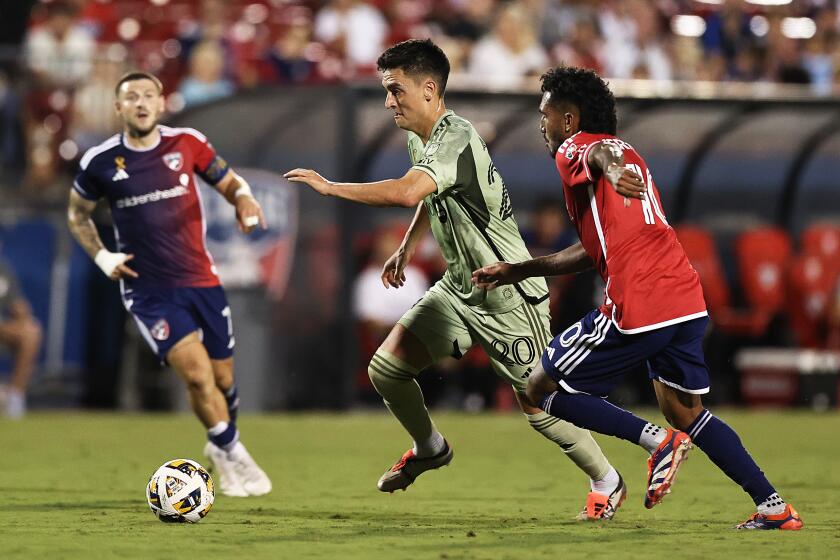U.S. Has Several Decisions to Make
Mia and Cindy? Mia and Tiffeny? Mia and Abby? Mia and Shannon?
The only thing certain about the United States’ lineup for its opening game in the Women’s World Cup -- against Sweden in Washington on Sunday -- is that Mia Hamm will be one of the 11 starters.
But Mia and who else? That’s the question.
Just which forward or combination of forwards Coach April Heinrichs will choose to play alongside international soccer’s all-time leading goal scorer remains a mystery even as the U.S. squad fine-tunes its offense at the University of Virginia.
The problem for Heinrichs and assistants Bill Palladino and Phil Wheddon is that they have so many offensive “weapons,” as Heinrichs calls them, that selecting only two or three can cause a headache.
In the team’s final warmup game, a 5-0 victory over Mexico in San Jose on Sept. 7, Heinrichs started a three-player front line, employing Hamm and the team’s “twin towers” of 5-foot-10 Abby Wambach and 5-11 Cindy Parlow.
“I like what those three give us in terms of their presence,” she said.
“Abby Wambach’s certainly dynamic in the air. Cindy Parlow’s dynamic in the air and with her feet and great [with her] back to pressure. Mia Hamm is all the things we know about Mia Hamm. She’s creative, she’s clever, she’s one versus one, she’s a slashing player, and she gives us speed.
“So we have a good back-to-pressure player, a good target player, two players good in the air, [and] Mia’s a great finisher and a flank player and slasher.
“With those three players, and Tiffeny Milbrett and Shannon [MacMillan] coming along still, I like our weapons and our looks in terms of how we can play up top.”
But who Heinrichs will start “up top” and whether she will elect to play two forwards or three has not been revealed.
Hamm and Wambach have the best goals-per-game averages on the 20-player U.S. roster, so it quite possibly could be those two who take the field against the Swedes at RFK Stadium.
They formed a close partnership while playing with the Washington Freedom this season and powered the team to its first Women’s United Soccer Assn. championship.
“We interacted great,” Hamm said. “You talk to her and she can’t wait to get this tournament started.
“She loved going out to practice every day [with the Freedom] and learning and making a difference. That kind of attitude is contagious. At times she single-handedly put our team on her back and carried us through.
“In that [WUSA] final, she was determined, regardless of what happened, to not let us lose. The work she’s done this season has put her on this [World Cup] team.”
The only qualms about Wambach involve her lack of international experience, especially at this level. She has played only 14 games for the United States, scoring nine goals, but is virtually untried against a world-class opponent such as Sweden, which is ranked fifth in the world.
The advantage there, of course, is that the Swedes will be unfamiliar with her.
Meanwhile, the likelihood is that Milbrett will be used off the bench, to spark the team if it runs into difficulties. She is extremely adept at that role, although she is equally effective as a starter.
MacMillan, meanwhile, will probably be used sparingly, if at all, during the first round as she continues to regain full fitness after knee surgery in May. She could be the team’s surprise weapon in the knockout phase.
Holding Milbrett and MacMillan in reserve would solve the offense problem if it were not for Parlow. She has the experience that Wambach lacks at the World Cup level, having started all six games when the United States won the world championship in 1999, and is a reliable goal scorer.
But if Heinrichs goes with three forwards, as she did against Mexico, she will be forced to employ a three-player midfield, and that presents another difficulty.
The U.S. has to have a defensive midfielder, and Shannon Boxx is fighting Tiffany Roberts for that role. Then too, Heinrichs is not going to leave two-time world champions and Olympic gold medalists Kristine Lilly and Julie Foudy on the bench -- especially not when they have scored 132 goals between them in international play.
Aly Wagner, meanwhile, would seem to be an absolute necessity as the creative playmaker in midfield.
So where does that leave Parlow? Either she starts and one of the midfielders is out, or she’s out and the U.S. plays a 4-4-2 formation, which seems unlikely.
In 1999, then-coach Tony DiCicco used three forwards -- Hamm, Parlow and Milbrett -- with MacMillan and Tisha Venturini coming of the bench when needed.
A year later, at the Sydney Olympics, Heinrichs used the 4-3-3 formation, with MacMillan, Milbrett and Hamm playing up front.
If history is the guide, therefore, she will use three this time too, intending to keep opponents back on the defensive.
The U.S. averaged three goals a game in winning the World Cup in 1999, outscoring its six opponents, 18-3.
Four years earlier, when finishing third in the Sweden ’95 Women’s World Cup, it averaged 2.5 goals a game and outscored its six opponents, 15-5.
And in the first Women’s World Cup in China in 1991, the eventual champion Americans did best of all, averaging 4.16 goals a game in sweeping aside opponents by a combined 25-5 goal margin.
The cutting edge of that first world championship team was the “triple-edged sword” of Michelle Akers, Carin Jennings and Heinrichs, backed by, among others, Hamm, Lilly and Foudy.
By the time the fourth Women’s World Cup begins Saturday, the U.S. “sword” might have a different shape, but it promises to be just as sharp.
*
U.S. Strike Force
FORWARDS
*--* Name Games Goals Avg* Abby Wambach 14 9 0.642 Mia Hamm 239 142 0.594 Tiffeny Milbrett 191 98 0.513 Cindy Parlow 128 62 0.484 Shannon MacMillan 155 58 0.374
*--*
ATTACKING MIDFIELDERS
*--* Name Games Goals Avg* Kristine Lilly 254 91 0.358 Aly Wagner 46 11 0.239 Julie Foudy 230 41 0.178 * Ranked by goals-per-game average
*--*



